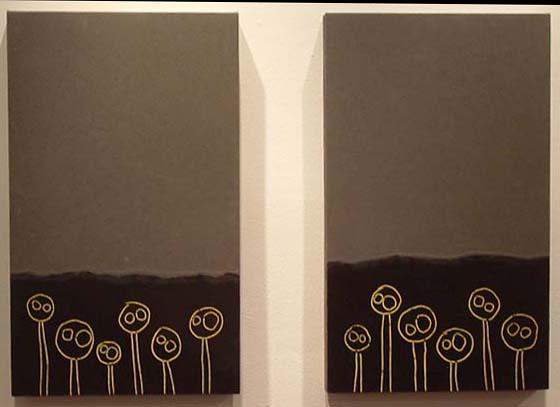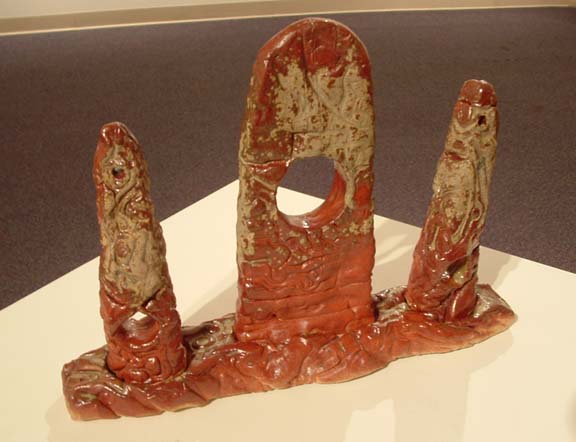Seeing Double and Triple at Washington Galleries
Julia Durst reports on the latest Washington Coop group show, Diptychs & Triptychs- A Series of Multiples, at Washington Galleries, 315 Lake Ave N in Duluth, through May 29.



Family dinners can be awkward. The whole clan shows up for some condensed-soup casserole, prompted by a holiday or funeral or rare convergence of busy schedules. Contrived but natural, these meals never fail to remind us how different we are (or want to be) from our brood.
When Washington Artists Cooperative in Duluth puts on a group show, it’s a little like a family dinner. Many show up; some are missing. A few talk a lot; others don’t say much. When everyone gathers, it becomes an exercise in contrast. Washington’s current show “Diptychs & Triptychs- A Series of Multiples” brings the gang together for a fantastic showing of new work. The content varies as much as the media, but the work is unified by one premise: it exists in two or three parts.
Painter Eric Dubnicka offers two diptychs in his characteristic style: textural color fields populated by linear, abstract heads in a toned-down palette. His work is something of a contradiction. It looks spontaneous with the occasional drip or splatter but is not; the ground of the paintings exposes labor-intensive perfectionism.
“Untitled (Pottery Barn)” is Dubnicka’s best offering here. A big, dark sky looms over a row of abstract bobbleheaded creatures in this subdued piece. With black, white, and a vaguely familiar shade of designer brown, the artist’s hues are delightfully yuppy. Dubnicka’s work proves itself over and over, and here is no exception.
Russ Gran also makes a solid showing with “Put a Lid on it,” a pop art commentary on curbing bad habits. The triptych shows three still lifes, each with a glass jar surrounded by empty prescription bottles, a lemon and red pepper lying among them. Each painting has a different vice in the jar: a wine glass, a pack of cigarettes, a Pringles-esque can of chips. Gran’s message is ambiguous– is he scolding us for our indulgences, or is he critiquing society and government for trying to curb our bad habits through laws and health recommendations? The lemon and pepper– bitter and hot– perhaps a commentary on choking down the prescriptions of others?
Gran’s palette is the best part. An Easter-egg assortment of yellow, periwinkle, and lollipop red, it could’ve been borrowed from the list of color options for L.L. Bean’s spring collection of seersuckers. The bright hues, paired with Gran’s precise brushwork, make for a slick, smart series.
“Fall of Man,” a triptych by David Gross, is one of the show’s best, strong in aesthetic and content. In these loose, gestural acrylic paintings, Gross uses mostly primary colors enhanced by black linear squiggles. The first panel shows a monkey, followed by a second depicting two bananas and four oranges arranged like a peapod, with bananas serving as the pod. The third panel shows the monkey again, altered slightly. His anatomy is a little warped– bigger monkey boobs, larger and sharper teeth, crazy monkey expression on his face.
The humorous take on this exhausted biblical theme is smart and well-executed. Each painting is strong enough to stand alone, the fruit one being the most dynamic. There’s ample room for further interpretation in the series. The center fruit panel could be perceived as an abstraction of female genitalia. The triptych could also be a comment on evolution, saying we came from monkeys, not Adam, tossing in bananas as “forbidden fruit” for a chuckle.
The show does go beyond painting. Patti Kremer’s “Fear is More Like Interfere” is fun, a play on words in a well-executed two-part fiber wall piece. Her “Earthly Shine for the Nature Lover” straddles the line between art and craft. The small wooden boxes covered entirely with photographic imagery (flowers, leaves, butterflies) take on a surprising presence when resting atop a white pedestal. Well-made and simply quite pretty, the boxes have a quiet appeal that elevates them above what must result from Thursday night classes for suburban housewives at the local Hobby Lobby store.
Ceramic artist Tony Ferguson displays “Ancient Ways- Sun Stones 1,” a small brownish sculpture consisting of three tall pierced pieces of clay. Its organic form is engaging, but it begs to be bigger, dwarfed by David Gross’s nearby mural-size triptych. Ferguson’s approach to the show’s theme differs from the rest. Another piece by him would have been welcome.
As usual, Ryan Amundson stretches our skills of interpretation in three new pieces. He makes use of distressed wood and a black/white/red color combo to create two wall-mounted series and one installation. The two wall works consist of deep, wooden square boxes behind glass panes. “It’s All For You” is the more innovative series. Amundson places a photo of cupped hands in the back of the box; in front of it are a web of red twine and a feather that looks like it’s levitating. The web becomes more sparse from one box to the next and vanishes in the last one, resulting in an elegant and minimal final piece in which the feather is poised to land in the hands
The show is one of the best group exhibits Washington has put on in the past few years. (The poetry/art collaborative show in early 2004 is a close second.) The diptych/triptych theme carries the show, allowing artists to pursue their own style and concepts while maintaining an overall unity in the gallery.
Washington Galleries (technically it’s just one two-room gallery) hosts about two group shows annually: one around the time of the Earth Day gallery hop, the other in December. They showcase work by the artists who live in Washington Artists Cooperative, a former school renovated into high-ceiling, big window live-work studios. The gallery is in the co-op building and has limited hours (1-5 on Saturday and Sunday, or by appointment).